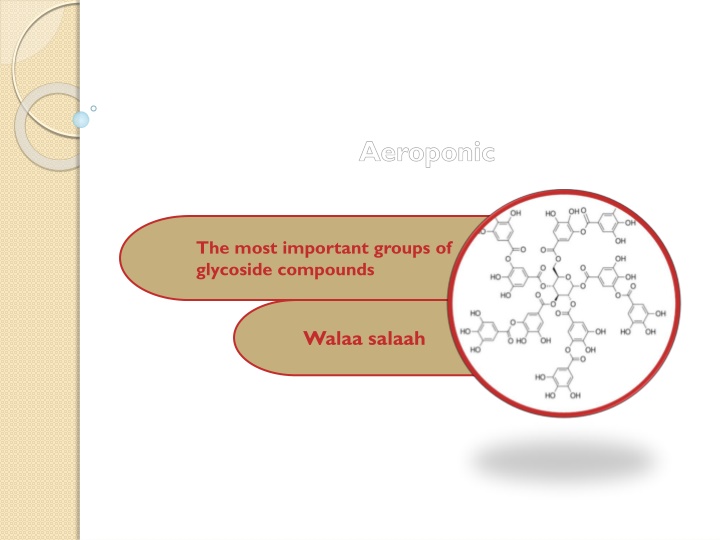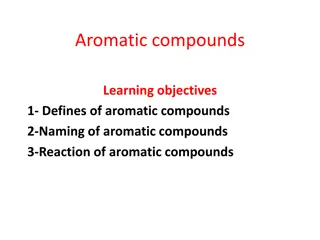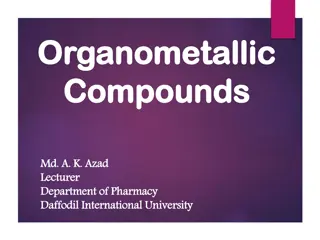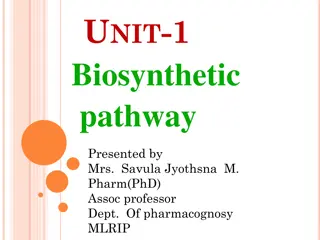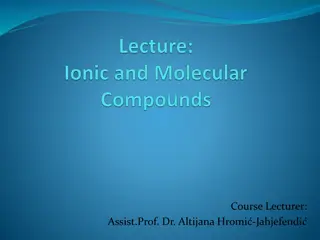Overview of Important Glycoside Compounds and Their Properties
Glycoside compounds play a significant role in various biological processes, with groups like steroids and cardenolides showcasing notable medicinal effects. Steroids are crystalline substances with specific solubility characteristics, while cardenolide glycosides are known for their toxic effects on animals. The alcoholic steroid group, including rare compounds like Ouabain, also has unique properties. Additionally, anthraquinones are natural phenolic compounds widely used in various industries. Understanding the properties of these compounds is crucial for their applications in different fields.
Download Presentation

Please find below an Image/Link to download the presentation.
The content on the website is provided AS IS for your information and personal use only. It may not be sold, licensed, or shared on other websites without obtaining consent from the author.If you encounter any issues during the download, it is possible that the publisher has removed the file from their server.
You are allowed to download the files provided on this website for personal or commercial use, subject to the condition that they are used lawfully. All files are the property of their respective owners.
The content on the website is provided AS IS for your information and personal use only. It may not be sold, licensed, or shared on other websites without obtaining consent from the author.
E N D
Presentation Transcript
The most important groups of glycoside compounds Walaa salaah
The steroid The steroid group is one of the most important glycoside compounds due to its medical effect in strengthening the heart, as it works to regulate the number of heartbeats and activate its muscles. Therefore, they are called cardiotonic glycosides, and they have a diuretic effect.
Chemophysical traits 1- Steroids are found in the form of solid crystalline crystal compounds, their colors range from white to light yellow, they taste very bitter and without smell. 2- Each steroid in this group has its own specific melting point and many of them have a certain degree of absorption by a certain UV and infrared rays. 3-Most of the steroids have little solubility in organic solvents, petroleum ether and water, but they dissolve in aqueous-alcoholic solutions such as Ethanol Methanol and water, and their solubility increases in these solvents as the number of sugar groups in the steroid compound increases. 4-Steroids easily hydrolyze when exposed to water, heat, yeasts, alkalis, or oxygen, and turn into other compounds that vary according to the type of agent they were exposed to. Chemophysical Properties .
Cardenolide A cardenolide is a type of steroid. Many plants contain derivatives, collectively known as cardenolides, including many in the form of cardenolide glycosides (cardenolides that contain structural groups derived from sugars). Cardenolide glycosides are often toxic; specifically, they are heart-arresting. Cardenolides are toxic to animals through inhibition of the enzyme Na+/K+ ATPase, which is responsible for maintaining the sodium and potassium ion gradients across cell membranes.
The group of alcoholic steroids These compounds contain an alcohol group attached to the carbon atom at the 10-C position, and a few compounds belong to this group and are rarely used in practice, for example, the glycoside Ouabain
Anthraquinones Anthraquinones (also known as anthraquinonoids) are a class of naturally occurring phenolic compounds based on the 9,10-anthraquinone skeleton. They are widely used industrially and occur naturally. Occurrence in plants Edit
Natural pigments that are derivatives of anthraquinone are found, inter alia, in aloe latex, senna, rhubarb, and cascara buckthorn, fungi, lichens, and some insects. A type II polyketide synthase is responsible for anthraquinone biosynthesis in the bacterium Photorhabdus luminescens.[1] Chorismate, formed by isochorismate synthase in the shikimate pathway, is a precursor of anthraquinones in Morinda citrifolia.[2] Tests for anthraquinones in natural extracts have been established.[3] Senna glycosides from the senna. Frangulin in Frangula alnus. Aloe-emodin in aloe resin. Carmine, a bright-red pigment derived from insects.[4] Hypericin and fagopyrin are naphthodianthrones, anthraquinone-derivatives.
Tannin Tannins (or tannoids) are a class of astringent, polyphenolic biomolecules that bind to and precipitate proteins and various other organic compounds including amino acids and alkaloids.
Structure and classes of tannins There are three major classes of tannins: Shown below are the base unit or monomer of the tannin. Particularly in the flavone- derived tannins, the base shown must be (additionally) heavily hydroxylated and polymerized in order to give the high molecular weight polyphenol motif that characterizes tannins. Typically, tannin molecules require at least 12 hydroxyl groups and at least five phenyl groups to function as protein binders.
tannins for plants Benefits for plants 1-Tannins are an important source of energy as they are consumed by plants after they are oxidized during food transformation processes. 2-Tannins have the property of attracting oxygen because they contain phenol, which increases the plant's ability to obtain oxygen. 3-Tannins are antiseptic substances that protect plants from fungal and insect diseases. 4- The concentration of tannins increases in the dead parts of the plant to protect the plant from the growth of the living organisms thrown on it.
